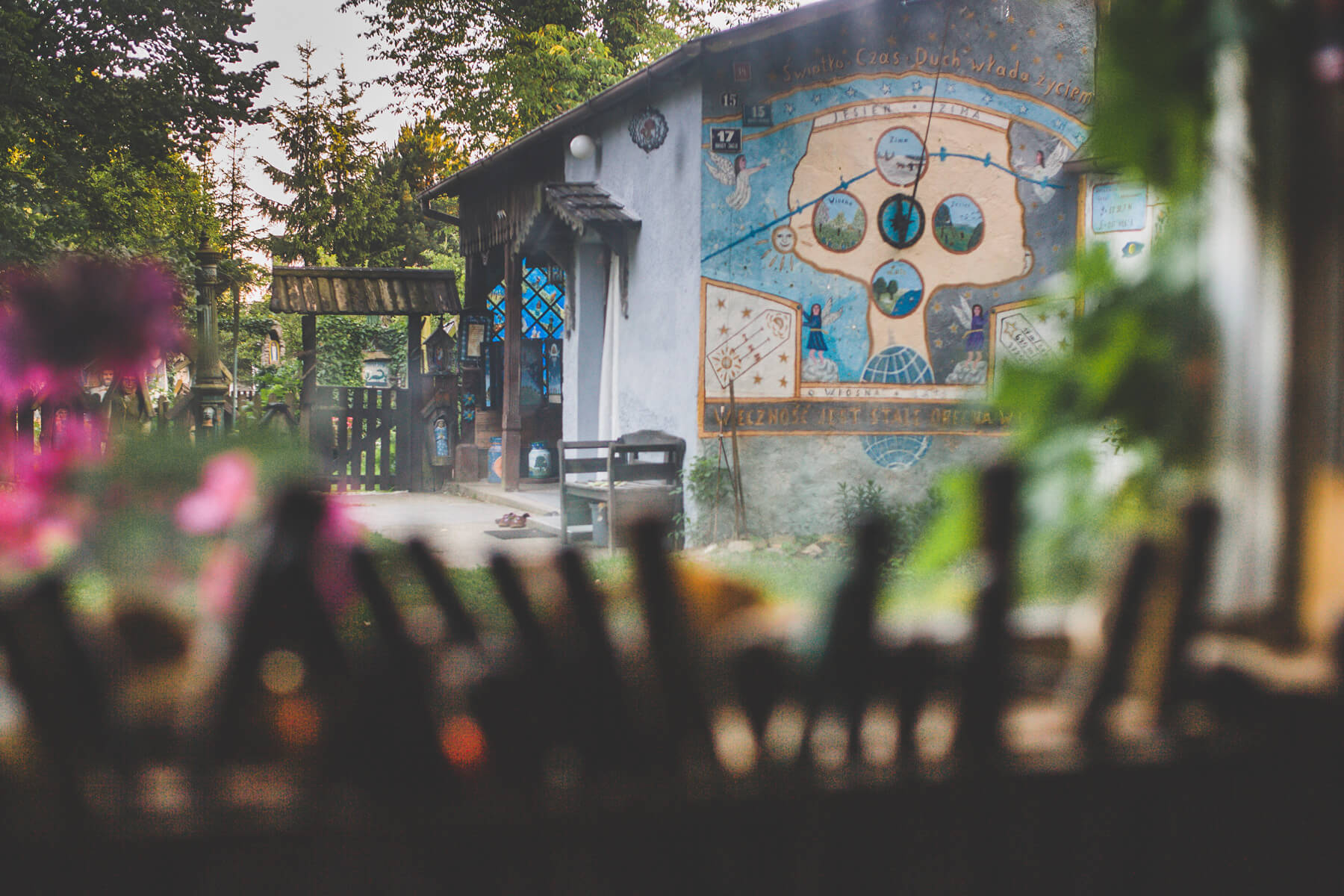Józef Chełmowski with his wife Jadwiga embellished the immediate surroundings – the house and the farmyard – in order to feel comfortable in it. They were also happy to invite guests into their private world. Chełmowski, without imposing himself on anyone, told only as much as the interlocutor seemed interested. Already during his lifetime, the house at Brusy-Jaglie 17 became a tourist attraction of the region, which was then described in many tourist guides. The meeting with the artist complemented the visit.
Household
Chełmowski is a Kashubian from his great-grandfather. The house, built by Józef’s grandparents, became his place in the world. He was born in this house. The spaces in the outbuilding and the family house are made available to interested tourists. Once residential rooms, today they are a beautiful memory of the busy life of the married couple. One of the rooms has been arranged by themselves into a home gallery. It is here that guests can admire hand-painted books, unusual Christmas nativity scenes and convex, three-dimensional and playing pictures. A keen eye will notice a rare pianola or inventions such as God’s Internet and God’s computer. Right under the ceiling there is an exhibition of mini monuments of significant personalities and historical events from the country and the world.
His painting studio was a modest little room behind the kitchen, where he worked mainly in winter. As befits such a place, the space is filled to the brim with his creativity. It is worth turning your head up here, because due to the lack of space on the walls, the artist decided to place his works also on the ceiling.
Workshop and yard
After leaving the main road, right behind the communal building – Chata Kaszubska, it is impossible to miss the entrance to the open-air museum. Here, guests can take a moment of reflection – the unique 4.5 meter high chapel “The Third Fall” will encourage them to do so. Józef Chełmowski was known for these chapels – they are scattered in many places not only at crossroads, but also in private yards. The one at the entrance has been serving the inhabitants of the village of Brusy-Jaglie, who gather every May evening to worship the Virgin Mary, for many years.
Going further along the birch alley, we pass the backyard gardens that were looked after by the Artist’s wife – Jadwiga. On the left, you can see a machine designed by Józef for catching elements – once full of colors, it turned happily on a windy or rainy day. Today you can see how
time has left its mark on her.
In the spacious courtyard there is a summer studio space along its left part, including a workshop and its covered extension, which were used by the Artist to work on larger objects.
Out of inner need and respect for the past, the workshop-related space was adapted to an exhibition of everything different. Many memories from the family home or holidays in the countryside will be revived. In addition to items once used in the household, ritual exhibits or old denominations, you can also see war artifacts.
To the left of the entrance there is the Artist’s summer studio. A solid blacksmith vise by the window. It is here that smaller sculptures, mostly made of linden wood, were made. Through the window you can see the yard with garden in the background. From this perspective, the choice of the northern wall of the house for the sundial also becomes justified. He could also see anyone who entered the yard from the window. The guest’s visit meant a short break for a conversation.
Orchard – Apiary
One cannot feel lonely in this orchard. Carved log hives arranged in lanes under the trees proudly present their charms. An unusual combination of a traditional form of beekeeping and sculptural folk craftsmanship. In the summer season, most of the figure hives had tenants. The bees had to equip the apartment themselves, because the beekeeper did not put frames into the hives. Life in such a hive went on in the summer months, because the trunks were not warming up. Bees could fly in through the mouth, pocket or the figure’s hand, and the beekeeper could look at them by opening the lid on the hive’s back. For years now, they have only served as a decoration, so walking among them is safe. After all, the creator used to say that this is an open-air museum rather than an apiary, and he simply does not want to force the bees to occupy the quarters for longer.
Over the inlets of his hives, Józef presents rural, Kashubian scenes, all with a pinch of humor. The literary hero Remus appears, women making soup out of pants and many idyllic scenes where life is slow. Smaller sculptures and chapels are hidden among the vegetation. The saint patron will protect from misfortunes, bring prosperity. With such support, life is somewhat easier.
